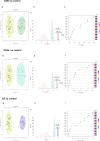Uncovering metabolic dysregulation in schizophrenia and cannabis use disorder through untargeted plasma lipidomics
- PMID: 39733019
- PMCID: PMC11682106
- DOI: 10.1038/s41598-024-83288-5
Uncovering metabolic dysregulation in schizophrenia and cannabis use disorder through untargeted plasma lipidomics
Abstract
Cannabis use disorder affects up to 42% of individuals with schizophrenia, correlating with earlier onset, increased positive symptoms, and more frequent hospitalizations. This study employed an untargeted lipidomics approach to identify biomarkers in plasma samples from subjects with schizophrenia, cannabis use disorder, or both (dual diagnosis), aiming to elucidate the metabolic underpinnings of cannabis abuse and schizophrenia development. The use of liquid chromatography-high resolution mass spectrometry enabled the annotation of 119 metabolites, with the highest identification confidence level achieved for 16 compounds. Notably, a marked reduction in acylcarnitines, including octanoylcarnitine and decanoylcarnitine, was observed across all patient groups compared to controls. In cannabis use disorder patients, N-acyl amino acids (NAAAs), particularly N-palmitoyl threonine and N-palmitoyl serine, showed a strong downregulation, a pattern also seen in schizophrenia and dual diagnosis patients. Conversely, elevated levels of 7-dehydrodesmosterol were detected in schizophrenia and dual diagnosis patients relative to controls. These findings suggest a potential link between metabolic disruptions and the pathophysiology of both disorders. The untargeted lipidomics approach offers a powerful tool to identify novel biomarkers, enhancing our understanding of the biological relationship between cannabis abuse and schizophrenia, and paving the way for future therapeutic strategies targeting metabolic pathways in these conditions.
Keywords: 7-dehydrodesmosterol; Acylcarnitines; Biomarkers; Cannabis Use Disorder; Lipidomics; N-acyl amino acids; Plasma; Schizophrenia.
© 2024. The Author(s).
Conflict of interest statement
Declarations. Competing interests: The authors declare no competing interests.
Figures



Similar articles
-
LC-HRMS Lipidomic Fingerprints in Serbian Cohort of Schizophrenia Patients.Int J Mol Sci. 2024 Sep 24;25(19):10266. doi: 10.3390/ijms251910266. Int J Mol Sci. 2024. PMID: 39408605 Free PMC article.
-
Characterizing acyl-carnitine biosignatures for schizophrenia: a longitudinal pre- and post-treatment study.Transl Psychiatry. 2019 Jan 17;9(1):19. doi: 10.1038/s41398-018-0353-x. Transl Psychiatry. 2019. PMID: 30655505 Free PMC article.
-
Lipidomics unveils lipid dyshomeostasis and low circulating plasmalogens as biomarkers in a monogenic mitochondrial disorder.JCI Insight. 2019 Jul 25;4(14):e123231. doi: 10.1172/jci.insight.123231. eCollection 2019 Jul 25. JCI Insight. 2019. PMID: 31341105 Free PMC article.
-
Lipidomics, Biomarkers, and Schizophrenia: A Current Perspective.Adv Exp Med Biol. 2017;965:265-290. doi: 10.1007/978-3-319-47656-8_11. Adv Exp Med Biol. 2017. PMID: 28132184 Review.
-
Analytical approaches for lipidomics and its potential applications in neuropsychiatric disorders.World J Biol Psychiatry. 2017 Oct;18(7):506-520. doi: 10.3109/15622975.2015.1117656. Epub 2016 Jan 26. World J Biol Psychiatry. 2017. PMID: 26555297 Review.
References
-
- Ibrahim, H. M. & Tamminga, C. A. Schizophrenia: Treatment targets beyond monoamine systems. Annu. Rev. Pharmacol. Toxicol.51, 189–209. 10.1146/annurev.pharmtox.010909.105851 (2011). - PubMed
-
- Kiburi, S. K., Molebatsi, K., Ntlantsana, V. & Lynskey, M. T. Cannabis use in adolescence and risk of psychosis: Are there factors that moderate this relationship? A systematic review and meta-analysis. Subst. Abus.42, 527–542. 10.1080/08897077.2021.1876200 (2021). - PubMed
-
- da Silva, F., Zandonadi, E. A., dos Santos, F., Marques, M. S. & Sussulini, A. Metabolomics: A powerful tool to understand the schizophrenia biology. In Neuroproteomics as a Tool for Understanding Schizophrenia (ed. Martins-de-Souza, D.) 105–119 (Springer International Publishing, 2022). 10.1007/978-3-030-97182-3_8. - PubMed
Publication types
MeSH terms
Substances
Grants and funding
LinkOut - more resources
Full Text Sources
Medical

